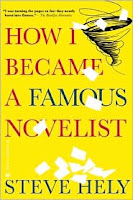 Every year I am somewhat surprised and dismayed to find that I have read barely any books on the "best of the year" booklists. One reason is that I don't restrict my reading at all to the current year's releases. I also may have different standards than the book reviewers.
Every year I am somewhat surprised and dismayed to find that I have read barely any books on the "best of the year" booklists. One reason is that I don't restrict my reading at all to the current year's releases. I also may have different standards than the book reviewers.Check out some of the lists for 2010:
Kirkus Reviews Top 25 Fiction
Kirkus Reviews Top 25 Nonfiction
Library Journal Top Ten
The New York Times Ten Best Books
The New York Times 100 Notable Books
Publishers Weekly Best Books
What do you think of the selections? Have you read any? I haven't--except for Let's Take the Long Way Home, by Gail Caldwell (a PW pick for best nonfiction).
Notable novels that I want to get around to reading:
Freedom, by Jonathan Franzen
Super Sad True Love Story, by Gary Shteyngart
Notable works of nonfiction that I'm interested in reading:
Autobiography of Mark Twain, Vol. 1, by Mark Twain
Country Driving: A Journey Through China from Farm to Factory, by Peter Hessler
Last Call: The Rise and Fall of Prohibition, by Daniel Okrent
Graphic by Sarah Illenberger for The New York Times




 A few weeks ago, I saw a theatrical production of And Then There Were None, adapted from the Agatha Christie novel of the same name (some editions were entitled Ten Little Indians). Did you know that it's the seventh bestselling book ever? And that Christie is the third bestselling author of all time, after the Bible and Shakespeare?
A few weeks ago, I saw a theatrical production of And Then There Were None, adapted from the Agatha Christie novel of the same name (some editions were entitled Ten Little Indians). Did you know that it's the seventh bestselling book ever? And that Christie is the third bestselling author of all time, after the Bible and Shakespeare?


 Anne Lamott is a talented writer of fiction and nonfiction. I had not read a book by her in awhile, so I was looking forward to her newly published novel, Imperfect Birds. She explained the title in an interview in the May/June issue of
Anne Lamott is a talented writer of fiction and nonfiction. I had not read a book by her in awhile, so I was looking forward to her newly published novel, Imperfect Birds. She explained the title in an interview in the May/June issue of  I recently came across this quote from actress Kim Cattrall: "I'm dating again, but I know nothing about men. They remain a mystery to me, other than that they are predictable."
I recently came across this quote from actress Kim Cattrall: "I'm dating again, but I know nothing about men. They remain a mystery to me, other than that they are predictable."
 I recently read The Unit, by Ninni Holmqvist (translated from the Swedish by Marlaine Delargy) and Never Let Me Go, by Kazuo Ishiguro. The dystopian genre to which these books belong has fascinated me since I was introduced to 1984 back when I was a high school sophomore.
I recently read The Unit, by Ninni Holmqvist (translated from the Swedish by Marlaine Delargy) and Never Let Me Go, by Kazuo Ishiguro. The dystopian genre to which these books belong has fascinated me since I was introduced to 1984 back when I was a high school sophomore.





